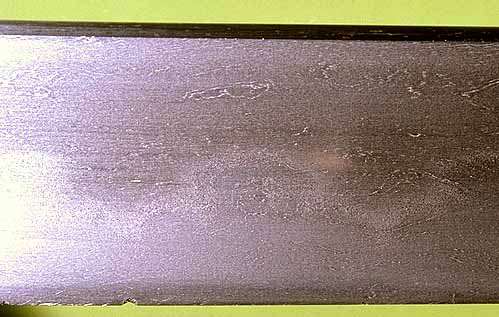

Nioi along the hamon in a Japanese dagger (tanto) blade inscribed Haku-shu Masatsuna (17th Century). The term "temper line" is a misnomer, as the hamon is a boundary formed at the time of quenching. The above photograph is a detail of a Japanese dagger (tanto) blade of the 17th Century. In the upper half of the picture we again see the wood grain pattern which results from the many layers of steel making up the blade. Additionally, a wandering misty pattern of increased brightness (nioi) may be seen about one-third of the way back from the edge which represents the "tempering line" (hamon), which is composed of a band of what metallurgists call martensite. Larger austenite crystals termed nie may also be observed, when cooling has been slower or the temperature higher, as have been exposed in the close-up photograph below of a tired (worn from many polishings) tanto. In Japanese swords, the differential tempering is achieved by a technique in which the swordsmith applies varying thicknesses of different types of clay to the surface of the blade before it is quenched. Thicker and more insulating clay over the back and body of the blade slows cooling and results in less brittle and more malleable iron there, while the edge cools more quickly and is harder, but also more brittle. In this way, a hard sharp edge may be part of a sword without excessively increasing the brittleness of the entire blade. (See also Kapp, 1987) Thus we see that aside from its overall form, two of the most critical features of the Japanese sword, the nature of its grain and its temper line, both reflect appearances which derive directly from the smith's attempts to optimize his material and to produce a strong, durable and sharp sword.

Nie along the hamon in a tired Mino tanto inscribed Munetsugu saku (15th Century). Nie may be more evident in overpolished blades, as the repeated polishings are exposing deeper areas which would have cooled more slowly when the sword was quenched.
<Return to previous part ~ Return to Table of Contents ^ ~ Go to next part >